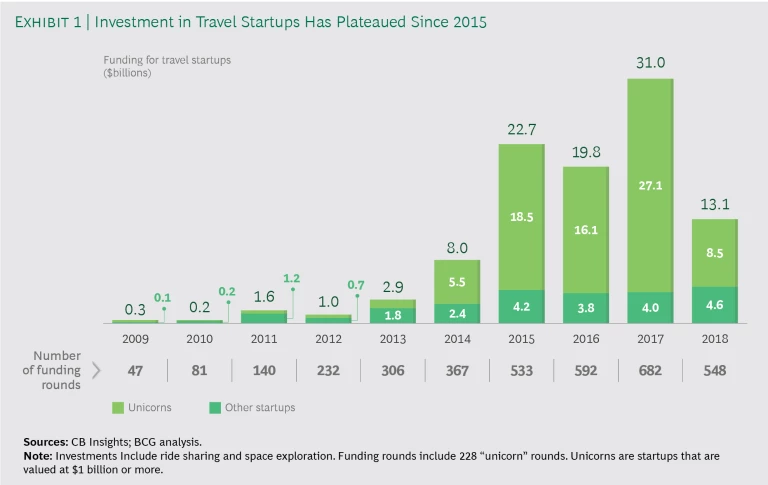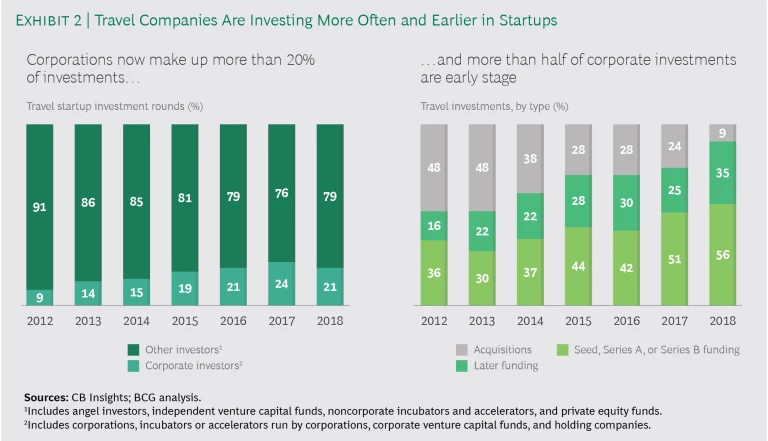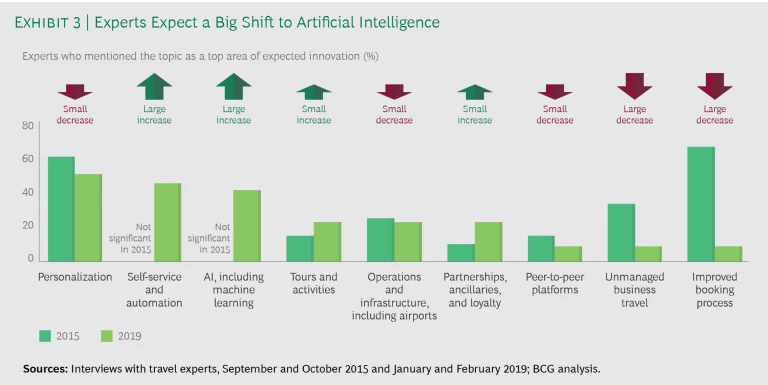To understand the state of innovation in travel, it’s important to study both the industry’s startups and its incumbents. In our review of the past three years, we found that in general, innovation has slowed, and—especially for incumbents—that innovation should focus more strongly on the customer experience.
Investment activity is a strong proxy for the level of innovation among startups. In 2018, overall venture funding for travel startups dipped to a four-year low, while the underlying “pulse” of funding—excluding a small set of “unicorns,” startups valued at $1 billion or more—has been creeping up much more slowly than in the first half of this decade. (See Exhibit 1.) At the same time, the focus of those investments has shifted from North America to Asia, so travelers in Europe and the US are less likely to experience any innovations that those investments generate in the short run.
Meanwhile, among incumbents, recent innovation has focused on efficiency and unbundling services—in other words, imposing charges for services that had been included in the base price—rather than on features that improve the travel experience for customers. With the growing presence of machine learning, these companies have unparalleled opportunities to personalize customer journeys and protect their control of the customer relationship. For this reason, we are cautiously bullish about travel innovation. We formed this view after interviewing 25 experts from travel and tech companies, travel industry startups, corporate venture funds, and incubators.
We are cautiously bullish about travel innovation.
The expectations of our expert panel members were lower in 2019 than the extreme bullishness expressed in Travel Innovated: Who Will Own the Customer? . But the message is remarkably similar. Traditional travel companies—airlines, hotel chains, and cruise lines—have a choice. They can actively shape the experience of their customers—through both internal development and participation in the broader open innovation ecosystem—or cede that role to, for example, the large tech companies. Inaction is a tacit invitation to tech companies to burnish their reputations as customer-friendly innovators while travel companies are reduced to commodity providers of hotel rooms and airplane seats.
Follow the Money
Overall funding for travel startups declined from $31 billion in 2017 to $13 billion in 2018. But to present a clear picture of the state of innovation, we prefer to exclude unicorns, such as the now public Uber and Lyft. Their inclusion can skew the view of entrepreneurial activity because, in some cases, they, like Lyft, take on massive late-stage funding prior to going public. Excluding these companies, funding rose by nearly 10% from 2015 to 2018, far less than in the years prior to 2015. The growth in investments into younger, smaller companies suggests that investors still have an appetite for travel investments.
Two other noteworthy trends are the rise of corporate participation in the startup market and a shift of the center of gravity to Asia.
Corporate Buy-In. Corporations are contributing a greater share of overall travel startup funding than just a few years ago. In 2018, for example, corporations participated in 21% of travel startup financings, compared with 14% in 2013. The share of corporate financing—24%—was even higher in 2017, but the multiyear trend is upward, while the share of venture funding has been slipping over the past decade. Coupled with travel companies’ experimentation with inhouse incubators and digital factories, these trends suggest that travel companies are continuing to view innovation as a priority.
Corporations are also investing in earlier financing rounds. In 2018, for example, 56% of corporate financings were in seed, Series A, and Series B rounds. Those three rounds made up just 30% of corporate travel-financing activity in 2013. Nearly half, or 48%, of all corporate startup investments in 2013 were for acquisitions. In 2018, only 9% of these investments were for acquisitions. (See Exhibit 2.)
These trends suggest that incumbents are willing to look outside their organizations for innovation and fresh ideas. For their open-innovation efforts to pay off, effective partnering and integration are critical.
The Asian Surge. In the case of Asia, investors are following the miles. The Chinese airline travel market grew from 440 million passengers in 2013 to more than 600 million in 2018. By 2022, China will likely be—in terms of numbers of passengers—a larger air travel market than the US. It’s no wonder then that the share of travel startup investments in Asia rose from less than 20% ten years ago to 36% today. Asian investors are responsible for about 85% of these investments, which is about the same percentage of North American travel startups funded by North American investors.
Many of these startups are offering Asia-specific solutions that address holes in the continent’s travel infrastructure. For example, China does not have a long history of credit card networks, privately owned travel companies, or intermediaries. Accordingly, most of the Asian innovations are unlikely to translate into a change in the travel customer experience in North America or Europe anytime soon.
Recent Innovation: Efficiency Versus Experience
Over the past decade, the innovation efforts of travel companies—excluding digital natives such as Airbnb—have focused on unbundling and identifying ways to extract more money from customers, who do not consider having to pay for meals, checked bags, early check-in, inflight entertainment, or extra legroom beneficial forms of innovation.
These moves are, of course, necessary for preserving the companies’ financial health. At US-based Spirit Airlines, the world leader in generating ancillary revenues, add-ons generate about $55 per customer per flight. A revenue management team dynamically prices checked and carry-on bags and the cost of each seat, taking into account demand, flight duration, and customer profiles.
At the same time, however, passengers and guests are being exposed to much more enriching “customer journeys” when they, for example, engage in online shopping. Consequently, they expect comparable care and attention in their travels. Airlines’ mobile apps now allow customers to change flights, view upgrade and standby lists, track flights, and order rental cars, while hotel apps facilitate checking in and out, upgrades, messaging with the front desk, and keyless room entry. Many of these innovations, however, were driven less by a desire to improve the customer experience than to reduce operating costs. Many customers like these apps, but others find them impersonal and burdensome.
Travel companies face at least two obstacles in their pursuit of innovation. First, they operate with thin margins, so the cost of replacing or updating legacy IT systems can be prohibitive. Second, many travel companies are simply risk averse and reluctant to place long-term bets. Several travel companies, for example, have launched and shuttered in-house incubators because the payoff was too slow.
Opening the Door for Tech Companies. Aversion to risk and a focus on efficiency create room for others to offer innovations that customers actually want. In general, tech companies—with their reams of customer data, talented programmers, and willingness to experiment and take risks—are leading the way. For instance, Google—through its search, customer review, mapping, calendar integration, and real-time alert capabilities—has done far more recently than any other company to improve the customer experience in travel.
Avoiding the Commodity Trap. Superior customer experience is a positive not only for the customer. It can lead to price premiums and higher loyalty and advocacy for companies that do it well—all the more reason that travel companies should not cede the innovation landscape to the tech companies.
Changing the Game for Startups. Although they can be agile and flexible, startups do not have access to the consumer data and resources of large tech companies. Accordingly, many startups have pivoted away from serving consumers to working directly with established travel companies.
This shift has not been easy. Incumbents have been willing to work with startups on peripheral functions, but they are understandably reluctant to let them work on core functions such as reservations, revenue management, and hotel operations. Furthermore, they already have in-house systems in these areas or are working with established vendors such as Amadeus and Oracle.
Future Innovation: The Power of Machines to Improve Customer Journeys and Operations
Artificial intelligence (AI) was on the minds of the travel experts we interviewed. Three years ago, in a prior version of this publication, we described the power of data to help provide a smooth and personalized travel experience, but the experts did not even mention AI. The situation has changed. In our discussions with the experts, AI was the innovation topic that—after personalization and self-service and automation—they mentioned most often. (See Exhibit 3.)
Personalization. AI and personalization are complementary. Travel companies have large amounts of information—especially indicators of customer behavior collected through loyalty programs—that they do not fully exploit. On the basis of customers’ previous interactions, AI can help travel companies by noting which services customers have accessed in other trips or would likely enjoy.
AI can also make the hotel or cruise ship experience more seamless and personalized. Using facial-recognition technology, for example, Royal Caribbean promises passengers that they will be able to get “from car to bar in 10 minutes.” And with AI, hotel guests can be automatically assigned to the types of room that they have enjoyed in the past.
Travel companies have rich opportunities for reaching their customers in new ways with AI. Companies can draw on a wide variety of customer data to suggest trip ideas that are likely to be of greatest interest, and travelers can respond, quickly booking trips through a choice of platforms, including mobile devices, chatbots, and voice assistants such as Alexa and Siri. If a trip is a recurring offering, the company can automate bookings on the basis of information in each customer’s calendar.
Travel companies have rich opportunities for reaching their customers in new ways with AI.
Operational Improvements. Travel companies should not abandon their AI and other innovation efforts in operations. In fact, improved operations and customer experience go hand in hand. Customers often interact with several travel companies at different stages of their journeys. Many of these situations, involving, for example, weather-related delays or unforeseen mechanical breakdowns, are emotionally charged and beyond the companies’ control. Nonetheless, it’s not at all unusual for customers to hold the companies responsible. AI can help companies anticipate and prepare responses to such lapses even when they are not at fault.
AI can help airlines avoid disruptions. For example, Dutch airline KLM and BCG are working together to develop AI-enabled decision support tools that can help predict delays, optimize aircraft and crew scheduling, and improve the passenger experience. With these tools, an airline can quickly analyze many scenarios, taking into account crew positions and availability, aircraft locations, and maintenance programs. Armed with such analyses, frontline staff can make integrated decisions that boost operational performance. Qantas has developed AI routing models that reduce the risk of delays and turbulence while minimizing fuel, crew, and costs.
Many of these data-based innovations will require connecting data across systems and companies. Several experts said that the International Air Transport Association’s efforts to provide a common data standard (through New Distribution Capability), a single record (through ONE Order), and open software (through Open API) will help enable that connectivity. Others emphasized the need to make sure that customers receive value in exchange for agreeing to share their personal information and to comply with privacy regulations such as the EU’s General Data Protection Regulation.
Seemingly far-off innovations such as electric vertical takeoff and landing (eVTOL) and fully autonomous planes and cars may be available much sooner than many realize, but they are still several years away. (See the sidebar “Innovation in Flight.”)
Innovation in Flight
Innovation in Flight
Recent innovation in travel has been modest, but several breakthrough technologies are nearing commercialization. In short-haul air travel, electric vertical takeoff and landing (eVTOL) air taxis and small fixed-wing electric aircraft are on the horizon. An on-demand eVTOL taxi will pick travelers up at their homes or offices and fly them directly to destinations within 500 miles. In January 2019, Boeing NeXt successfully tested an eVTOL aircraft: it took off, hovered, and landed on its own.
For trips of up to 700 miles, more cost-conscious travelers might opt for a hybrid jet or turboprop. These planes will offer lower-cost and more environmentally sustainable travel, even if the batteries are not yet economical for purely electric air travel. Boeing HorizonX and JetBlue Technology Ventures are backing Zunum Aero in its development of electric aircraft. With cruising speeds as high as 340 miles per hour and a cost-per-average seat mile of $.08, these aircraft could compete with traditional aircraft and open new routes. Zunum Aero aircraft can optionally be piloted remotely, helping address the pilot shortage. The company expects the first flight of its 12-seat aircraft in 2020. Subsequent models will be designed for up to 50 passengers.
Travel Companies Can Avoid the Commodity Trap by Working with Startups
Three years ago, we asked, How can travel suppliers protect their place in the value chain? The question remains relevant today, even if the context has changed. At the time, startups appeared to be a larger threat. Today, the tech companies are playing a more passive role than we had anticipated, funneling traffic to direct channels rather than competing directly against travel incumbents.
Even so, travel companies should be concerned about the risk of ending up as commodity providers while big tech companies own the customer relationships. Travel companies should be sharpening their focus on customer-centric innovations and improving the customer relationship—even at the risk of disrupting their own businesses. They certainly need to be willing to work with startups simply to gain access to their talent and creativity. These collaborations and partnerships will require changes in context in at least three areas.
Travel companies should be concerned about the risk of ending up as commodity providers while big tech companies own the customer relationships.
Alignment. Travel companies’ executives and middle managers need to be willing to work with startups and incorporate their innovations. To move beyond the not-invented-here mindset, travel companies will need to rethink their KPIs and incentives. For example, JetBlue tied the compensation and KPIs of senior executives to the success of its JetBlue Technology Ventures incubator. With the proper incentives in place, JetBlue executives now willingly work directly with the management teams of companies funded by the incubator.
Agility. Travel companies need to be able to create hassle-free partnerships with startups. And they need mechanisms for seamlessly connecting their IT systems with those of their partners. JetBlue Technology Ventures, for example, has built fast-track procedures that accelerate collaboration between portfolio companies and divisions of the airline.
In interviews, travel startup executives complained about the multiyear processes and high legal expenses they incur in partnering with travel companies, which too often try to push startup partnership development through extended procurement and legal processes designed for billion-dollar aircraft orders. Even if an initiative survives that gauntlet, complete implementation can sometimes take years.
Attitude. Travel companies need to take a more venture-capital-oriented approach to innovation. Travel executives seem to forget that nine out of ten startups—and internal innovation projects—fail. Even successes are unlikely to generate profits for a long time. It’s not unreasonable to expect a large travel company to manage a diversified portfolio of 30 to 50 internal projects and external partnerships.
Travel companies should view their partners as equals rather than subordinates. In too many cases, the travel company dictates contract terms—insisting, for example, on exclusivity—that turn off the startups with the best ideas. In fact, they should be willing to, like JetBlue Technology Ventures, introduce the startups to other companies in the travel industry.
To increase the odds that they benefit from rather than face the consequences of disruption, incumbents should welcome and engage with potential disruptors. JetBlue Technology Ventures’ involvement with Joby Aviation, an eVTOL startup, and Zunum Aero, a hybrid-electric-aircraft startup, exemplifies willingness to make long-term investments even at the risk of business model disruption.
Change in Context. With data a key element of many innovation trends, travel companies need to recapture the advantage that they have ceded to Google and others. It may make sense for industry participants to band together or for individual companies to work with their cobranded credit card partners to strengthen their understanding of their customers’ needs. At the same time, they should take steps to assure their customers that they will receive benefits in exchange for allowing the use of their data. This is ground that travel companies must recapture if they want to provide their customers with a seamless, friction-free, and relevant experience.
By developing a more open approach to innovation—especially when it benefits the customer experience—established travel companies can remain relevant in the face of competition from the large technology companies. Innovation is one way these companies can avoid being viewed— and ultimately valued—as providers of a commodity.












